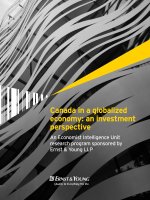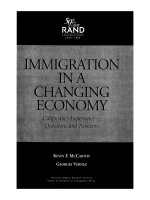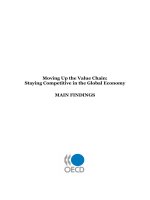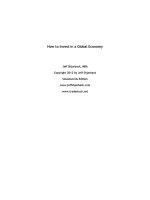Managing in a global economy by john marthinsen babson MBA chapter 08
Bạn đang xem bản rút gọn của tài liệu. Xem và tải ngay bản đầy đủ của tài liệu tại đây (3.9 MB, 37 trang )
CHAPTER 8
Who Controls the Money Supply and How?
Copyright© 2008 South-Western, a part of Cengage Learning. All rights reserved.
Exhibit 8-1
M2 Money Supply ≡ M2 Money Multiplier × Monetary
Base
Copyright© 2008 South-Western, a part of Cengage Learning. All rights reserved.
Exhibit 8-2
Framework for Conceptualizing Causes of Monetary
Base Changes
Copyright© 2008 South-Western, a part of Cengage Learning. All rights reserved.
Exhibit 8-3
What Causes Changes in the Monetary Base?
Copyright© 2008 South-Western, a part of Cengage Learning. All rights reserved.
Exhibit 8-4
What Causes the Monetary Base to Increase?
Copyright© 2008 South-Western, a part of Cengage Learning. All rights reserved.
Exhibit 8-5
Assets a Central Bank Could Purchase to Increase the
Monetary Base
Copyright© 2008 South-Western, a part of Cengage Learning. All rights reserved.
Exhibit 8-6
Assets Purchased by Central Banks
Copyright© 2008 South-Western, a part of Cengage Learning. All rights reserved.
Exhibit 8-7
Sources of Money Supply Changes
Copyright© 2008 South-Western, a part of Cengage Learning. All rights reserved.
Exhibit 8-8
Effects of Different Reserve Requirements
Copyright© 2008 South-Western, a part of Cengage Learning. All rights reserved.
Exhibit M8-1
Effects of a $10 Million Withdrawal from a Bank with
No Excess Reserves
Copyright© 2008 South-Western, a part of Cengage Learning. All rights reserved.
Exhibit 8-9
Monetary Effects of Open Market Operations
Copyright© 2008 South-Western, a part of Cengage Learning. All rights reserved.
Exhibit 8-10
Dominant Type of Open Market Operations and
Securities that Central Banks Purchase Outright or Use
for Repurchase Agreements: 2002
Source: Richard W. Kopcke, "The Practice of Banking in Other Industrialized Countries,’’ New England
Economic Review, Second Quarter 2002, 6. Also available online at
(accessed September 11, 2006).
*CG means central government.
Copyright© 2008 South-Western, a part of Cengage Learning. All rights reserved.
Exhibit 8-11
Monetary Effects of Foreign Exchange
Market Intervention
Copyright© 2008 South-Western, a part of Cengage Learning. All rights reserved.
Exhibit 8-12
Monetary Effects of Discount Rate and Discount Loan
Changes
Copyright© 2008 South-Western, a part of Cengage Learning. All rights reserved.
Exhibit 8-13
Standing Facilities at the Central Banks of Major
Industrial Nations: 2002
Source: Richard W. Kopcke, ‘‘The Practice of Banking in Other Industrialized Countries,’’ New England
Economic Review, Second Quarter 2002, 6. Also available online at />neer/neer2002/neer202a.pdf (accessed September 11, 2006).
*MC means market ceiling. It is the rate the central bank charges on a fixed-term loan. MF means market floor.
It is the deposit rate given on bank deposits at the central bank.
Copyright© 2008 South-Western, a part of Cengage Learning. All rights reserved.
Exhibit 8-14
Stock Market Prices of Seven Blue Chip U.S. Companies,
1929 and 1932
Sources: AT&T Historic Stock Data, (accessed June 5, 2006); The Wall Street Journal,
‘‘New York Stock Exchange Transactions,’’ September 4, 1929, 32 (accessed through ProQuest, June 5, 2006);
The Wall Street Journal, ‘‘New York Stock Exchange Transactions,’’ December 31, 1932, 32 (accessed through
ProQuest, June 5, 2006).
Copyright© 2008 South-Western, a part of Cengage Learning. All rights reserved.
Exhibit 8-15
Lags in Monetary Policy
Copyright© 2008 South-Western, a part of Cengage Learning. All rights reserved.
Exhibit 8-16
Major Monetary Tools of Central Banks and Their Effect
on the Money Multiplier or Monetary Base
Copyright© 2008 South-Western, a part of Cengage Learning. All rights reserved.
Exhibit A8-1
Major Accounts in a Central Bank Balance Sheet
Copyright© 2008 South-Western, a part of Cengage Learning. All rights reserved.
Exhibit A8-2
Composition of Industrialized Nations’ Central Bank
Assets: 2002
Source: Richard W. Kopcke, ‘‘The Practice of Banking in Other Industrialized Countries,’’ New England
Economic Review, Second Quarter 2002, 7. Also available online at />neer/neer2002/neer202a.pdf (accessed September 11, 2006).
Copyright© 2008 South-Western, a part of Cengage Learning. All rights reserved.
Exhibit A8-3
How Paper Currency Enters the Economy
Copyright© 2008 South-Western, a part of Cengage Learning. All rights reserved.
Exhibit A8-4
Cash Injections into the Economy Do Not
Change the Monetary Base
Copyright© 2008 South-Western, a part of Cengage Learning. All rights reserved.
U.S. Federal Reserve Note
Copyright© 2008 South-Western, a part of Cengage Learning. All rights reserved.
U.S. Federal Reserve Note
Copyright© 2008 South-Western, a part of Cengage Learning. All rights reserved.
Exhibit A8-5
Open Market Operations: Central Bank Purchases
Securities from Banks
Copyright© 2008 South-Western, a part of Cengage Learning. All rights reserved.









